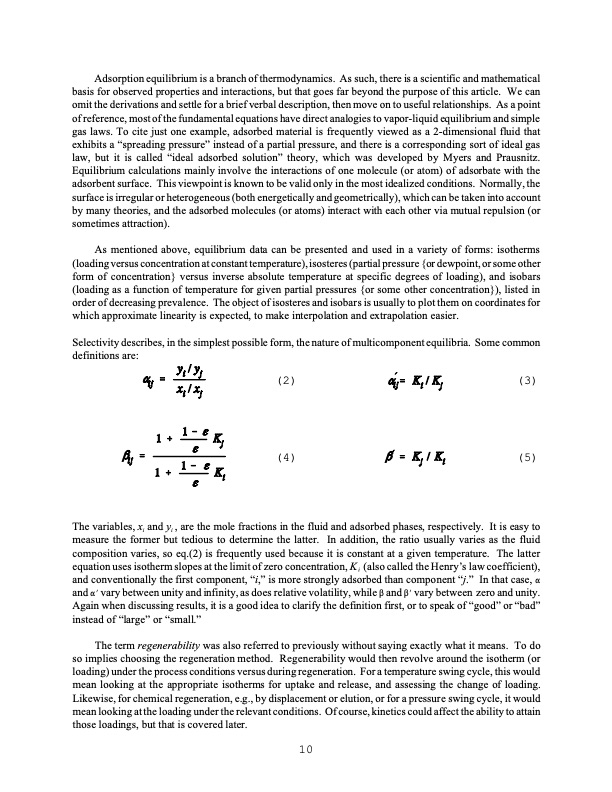
PDF Publication Title:
Text from PDF Page: 012
Adsorption equilibrium is a branch of thermodynamics. As such, there is a scientific and mathematical basis for observed properties and interactions, but that goes far beyond the purpose of this article. We can omit the derivations and settle for a brief verbal description, then move on to useful relationships. As a point of reference, most of the fundamental equations have direct analogies to vapor-liquid equilibrium and simple gas laws. To cite just one example, adsorbed material is frequently viewed as a 2-dimensional fluid that exhibits a “spreading pressure” instead of a partial pressure, and there is a corresponding sort of ideal gas law, but it is called “ideal adsorbed solution” theory, which was developed by Myers and Prausnitz. Equilibrium calculations mainly involve the interactions of one molecule (or atom) of adsorbate with the adsorbent surface. This viewpoint is known to be valid only in the most idealized conditions. Normally, the surface is irregular or heterogeneous (both energetically and geometrically), which can be taken into account by many theories, and the adsorbed molecules (or atoms) interact with each other via mutual repulsion (or sometimes attraction). As mentioned above, equilibrium data can be presented and used in a variety of forms: isotherms (loading versus concentration at constant temperature), isosteres (partial pressure {or dewpoint, or some other form of concentration} versus inverse absolute temperature at specific degrees of loading), and isobars (loading as a function of temperature for given partial pressures {or some other concentration}), listed in order of decreasing prevalence. The object of isosteres and isobars is usually to plot them on coordinates for which approximate linearity is expected, to make interpolation and extrapolation easier. Selectivity describes, in the simplest possible form, the nature of multicomponent equilibria. Some common definitions are: (2) (3) (4) (5) The variables, xi and yi , are the mole fractions in the fluid and adsorbed phases, respectively. It is easy to measure the former but tedious to determine the latter. In addition, the ratio usually varies as the fluid composition varies, so eq.(2) is frequently used because it is constant at a given temperature. The latter equationusesisothermslopesatthelimitofzeroconcentration,Ki (alsocalledtheHenry’slawcoefficient), and conventionally the first component, “i,” is more strongly adsorbed than component “j.” In that case, " and "N vary between unity and infinity, as does relative volatility, while $ and $N vary between zero and unity. Again when discussing results, it is a good idea to clarify the definition first, or to speak of “good” or “bad” instead of “large” or “small.” The term regenerability was also referred to previously without saying exactly what it means. To do soimplieschoosingtheregenerationmethod. Regenerabilitywouldthenrevolvearoundtheisotherm(or loading) under the process conditions versus during regeneration. For a temperature swing cycle, this would mean looking at the appropriate isotherms for uptake and release, and assessing the change of loading. Likewise, for chemical regeneration, e.g., by displacement or elution, or for a pressure swing cycle, it would mean looking at the loading under the relevant conditions. Of course, kinetics could affect the ability to attain those loadings, but that is covered later. 10PDF Image | ADSORBENT SELECTION

PDF Search Title:
ADSORBENT SELECTIONOriginal File Name Searched:
AdsorbentSel1B.pdfDIY PDF Search: Google It | Yahoo | Bing
CO2 Organic Rankine Cycle Experimenter Platform The supercritical CO2 phase change system is both a heat pump and organic rankine cycle which can be used for those purposes and as a supercritical extractor for advanced subcritical and supercritical extraction technology. Uses include producing nanoparticles, precious metal CO2 extraction, lithium battery recycling, and other applications... More Info
Heat Pumps CO2 ORC Heat Pump System Platform More Info
| CONTACT TEL: 608-238-6001 Email: greg@infinityturbine.com | RSS | AMP |